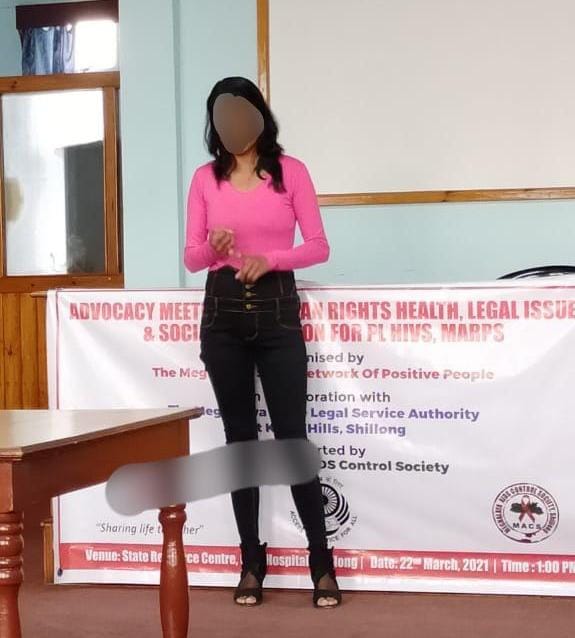By Preana Chettri
Shillong, Oct 23: The struggle of living with HIV lies in fighting the stigma and discrimination and it takes courage to face the social realities. One such fighter and survivor is V. Suchiang, who has been living with HIV and all the challenges that come with it – physical and social – ever since she was diagnosed for the virus in 2010.
Born and brought up in Shillong, Meghalaya, Suchiang and her family’s life took a sharp turn when she and her husband were diagnosed with HIV in 2010. If that was not all, their 2-year-old daughter was also found HIV positive.
“I remember the moment I got the news, all I wanted to know was, what is going to happen further? I was utterly embarrassed and uneducated on the subject. I thought as if there was a bomb threat,” she recalls.
When Suchiang received her HIV diagnosis she thought she was going to die. The fact that her daughter also tested positive made her feel devastated. But, as a mother, she never viewed the world through rose-colored glasses; instead she learnt how to take its thorns in stride.
“Nothing has been tougher in life” Suchiang says.
Concerned about her daughter’s treatment, Suchiang reached out to renowned Doctors from NEIGRIHMS in Shillong who later referred her to one of the Government hospital in Guwahati for her daughter’s treatment as she was just 2-yrs-old with several health complications. Adding to the sorrow and a clear case of discrimination, one of the major hospitals in Guwahati denied treatment to her daughter as she was HIV positive patient, alleged Suchiang.
“When I told the staff that my daughter was HIV positive they returned my admission and claimed some vague reasons for not taking the treatment any further.”
“It is really unfortunate that doctors and supporting staffs shy away from their duties,” she expressed.
With hospitals few and far apart and a negligible testing capacity, Suchiang had no choice but to get back to Shillong and begin with her daughter’s treatment in NEIGRIHMS.
“People think that HIV only leads to death, but that is not true; me and my daughter have proved to the world that you can live a healthy life with HIV and we’re still leading one.”
Suchiang believes that happiness is a personal choice and that has made all the difference, despite challenges that have rocked her life time and again.
Social Stigma
Stigma and discrimination was one major challenge Suchiang faced back in 2010. For her, the most devastating effects of stigma and discrimination were those that came from social rejection.
Suchiang feared rejection from families not only because she would lose her social place of belonging, but also because she could lose the ability to survive. For Suchiang, social rejection led her suffering from low self-esteem and depression.
Break the wall
Somewhere the walls have to be broken, and someone has to break it. And it was Suchiang who had the courage to stand up on her own to battle all those negativity.
“Me and my daughter are at peace and freedom. I receive love, hugs, well wishes from people around. It moves me to continue to share my story,” says Suchiang who is very much thankful towards the co-founder of MSNP, Agui Bemaie and her sister who always stood by her side.
The road ahead
Today Suchiang is spreading awareness and debunking the taboo around HIV/AIDS as an activist and as an active member of MSNP. Suchiang also focuses on informing people living with the virus about government schemes, healthcare facilities and available treatment option.
 HIV/AIDS in India
HIV/AIDS in India
HIV infection in India was first detected in 1986 among female sex workers in Chennai. The World Factbook report by the Central Intelligence Agency (CIA) estimates about 2.3 million People Living with HIV (PLHIV) in India in 2020, making it home to second largest population of PLHIV.
– National AIDS Control Organization (NACO) in 2019 estimated the PLHIV in India to be about 23.48 lakh.
– India’s epidemic is concentrated among key affected populations, including sex workers and men who have sex with men. The National AIDS Control Programme has made particular efforts to reach these two high-risk groups with HIV interventions.
– Compared to neighbouring countries, India has made good progress in reducing new HIV infections by half since 2001.
– Despite free antiretroviral treatment being available, uptake remains low as many people face difficulty in accessing clinics.
Voluntary counselling, testing and Accessibility
Data clearly show that HIV has spread to all groups of Indian society. Over 90% of those infected with the virus are not aware of their status. Most diagnoses occur at late stages of the infection. While the number of voluntary counselling and testing centres is on the rise in both government and non‐governmental settings in India, facilities have been underused because of (a) inaccurate perceptions of personal risk, (b) a widespread belief that HIV is restricted to high risk populations such as sex workers, drug users, and truck drivers, and (c) the persistence of stigma surrounding HIV.
It is essential to strengthen all testing protocols to include referral of HIV positive clients to well established treatment, care, and support facilities. Anecdotal evidence suggests that the disclosure of a positive test result in the absence of proper guidance and counselling may lead some patients to access inappropriate medical treatment, suffer depression, contemplate or commit suicide, and even engage in high risk activities with intent to further transmit their infection.



